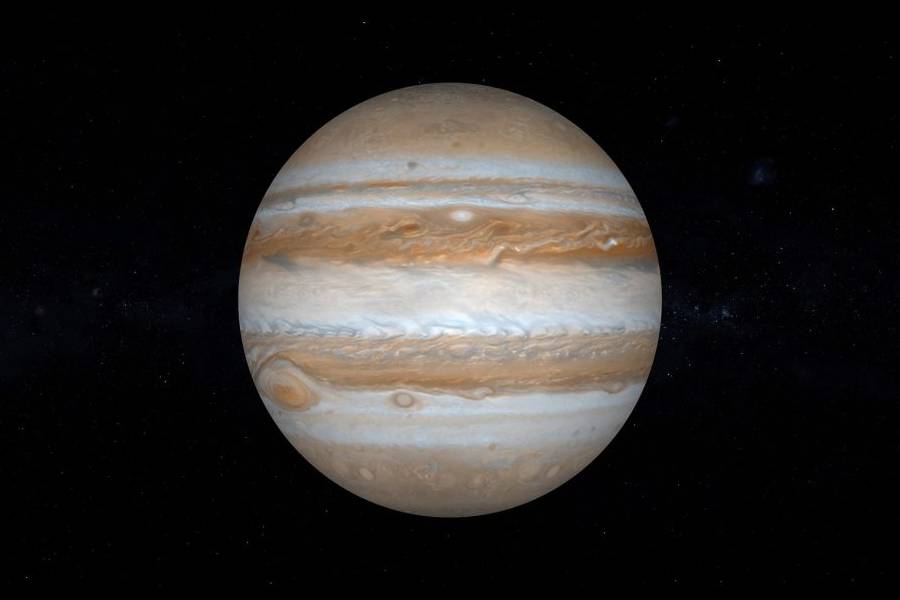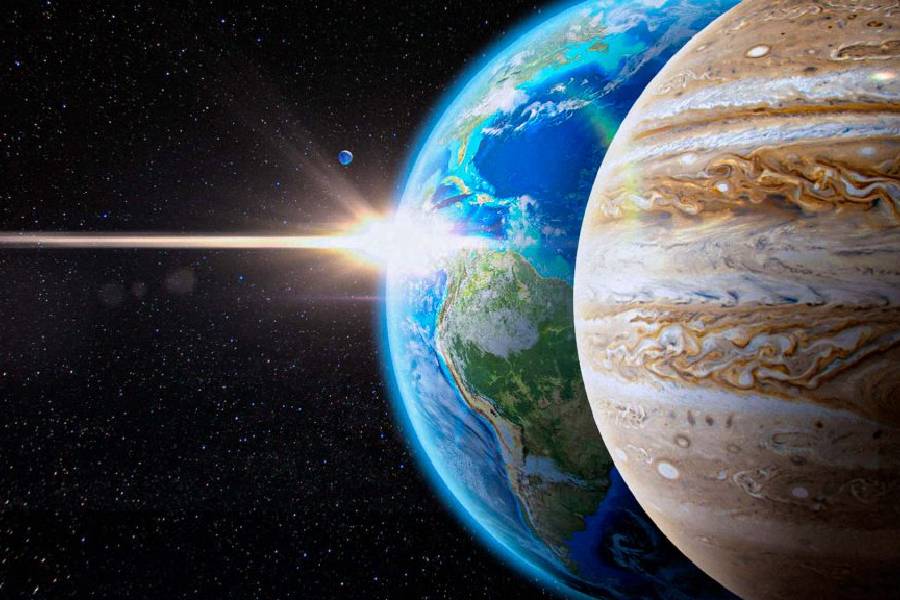Few of the planets visible to the naked eye spark the imagination, like Jupiter. Since ancient times, this gas giant has enthralled stargazers with its beauty, sheer size, and mysteries.
Even today, backyard astronomers eagerly await ideal conditions to glimpse Jupiter’s cloud bands, Great Red Spot, and circling moons through their telescopes. Beyond an enticing visual spectacle, Jupiter also holds clues to our solar system’s origins and planetary formation properties.
Knowing this giant’s key traits gives insight into the forces shaping the neighborhood around our Sun. In this article, we’ll explore some of the most defining Jupiter characteristics and why they intrigue astronomers.
So, let’s delve into the essential qualities distinguishing the mighty Jupiter.

What Are the Jupiter Characteristics?
Jupiter’s outstanding features include being the largest planet in our solar system. However, it’s also known for its distinctive cloud bands, the Great Red Spot, a ring system, and various moons.
Additionally, Jupiter is predominantly composed of hydrogen and helium, and it significantly influences the dynamics of our solar system.
Jupiter’s Physical Features
Size and mass
Jupiter is by far the largest planet in our solar system, with a mean diameter of 43,440.7 miles (69,911 kilometers). Jupiter’s mass is 1.898 x 10^27 kg, which is equivalent to 318 times the mass of Earth.
This makes Jupiter’s mass 2.5 times that of all the other planets in the solar system combined. If Jupiter was hollow, approximately 1,300 Earths could fit inside it. Jupiter’s rapid rotation causes it to bulge significantly at the equator and flatten at the poles. Due to this rotation-induced shape distortion, Jupiter’s equatorial and polar radii differ by over 10,000 km.
Distinctive cloud bands
Jupiter is covered in a series of alternating light and dark-colored cloud bands that encircle the planet parallel to its equator. The lighter color bands are called zones, while the darker ones are called belts.
These bands consist of swirling clouds at different altitudes, moving in opposite directions relative to Jupiter’s rotation. The lighter zones are regions of rising atmosphere, while the belts denote sinking air. The bands vary in number and appearance as they are connected to large storm systems within Jupiter’s dynamic atmosphere.
The Great Red Spot
The Great Red Spot is a giant, long-lived storm system in Jupiter’s southern hemisphere. It is the largest storm known in the solar system, with dimensions large enough to engulf the entire Earth. It has persisted for at least 400 years, observed since the early 19th century, but potentially extended further.
Inside this gigantic, hurricane-like structure, winds peak at approximately 270 mph. The cloud towers making up the storm extend several kilometers above the surrounding cloud layers. The striking red color may come from chemical interactions within Jupiter’s atmosphere, but the exact components are still unknown.
Rings
While less substantial than Saturn’s rings, Jupiter does possess a set of faint rings composed primarily of small dust particles. These particles originate from some of Jupiter’s smaller inner moons, as well as debris from asteroid and comet impacts.
The main ring is broad but extremely thin, extending inward to about 92,000 km from Jupiter’s center. Jupiter also has three other narrow rings, including the halo, the Gossamer, and the Amalthea gossamer rings. Though quite diffuse, these rings circle Jupiter at a distance comparable to its four largest moons.

Composition of Jupiter
Gas giant status
Jupiter is categorized as a gas giant planet, along with Saturn, Uranus, and Neptune in our solar system. Unlike terrestrial planets, which have denser, rocky surfaces, gas giants are composed primarily of lighter gases like hydrogen and helium.
Jupiter does not have a defined surface, but rather, its gaseous makeup becomes gradually denser toward the core.
Atmospheric composition
Jupiter’s visible atmosphere is about 86% hydrogen and 13% helium by volume. The remaining 1% contains traces of methane, ammonia, hydrogen sulfide, water vapor, and other compounds.
The upper cloud layers are made of ammonia ice, while lower cloud decks consist of ammonium hydrosulfide and water. Upwelling convection currents and powerful storms constantly mix these cloud layers.
The role of hydrogen and helium
Hydrogen and helium dominate Jupiter’s composition because of conditions during the planet’s formation. In the early solar system, Jupiter accrued much of the primordial hydrogen and helium.
The intense pressure from Jupiter’s enormous mass compressed these light gases, enhancing the fusion of hydrogen into liquid metallic form near the core. This metallic hydrogen layer accounts for Jupiter’s powerful magnetic field. Helium rain is believed to fall through the outer layers and collect at the core as well.
Overall, the abundances of hydrogen and helium, along with traces of other compounds, reflect Jupiter’s origins and subsequent evolution as a gas giant planet. The dynamics of these lighter elements contribute to Jupiter’s stormy, turbulent atmosphere and internal structure.
Jupiter’s Moon Marvel
The four largest moons of Jupiter, now called the Galilean moons, were first observed by Galileo Galilei in 1610 using an early telescope. These include Io, Europa, Ganymede, and Callisto. The Galilean moons span in size from Io at 2,264 miles in diameter to Ganymede at 3,273 miles in diameter, larger than the planet Mercury. They orbit between 400,000 km and 2 million km from Jupiter.
Furthermore, over 80 natural satellites have now been detected orbiting Jupiter. Also, additional moons were discovered sporadically between the 17th and 20th centuries. But the pace increased rapidly starting in the 1970s with telescopic surveys that uncovered Jupiter’s outer, irregular, retrograde moons.
Recent counts confirm 95 moons, with the potential for more yet to be discovered. Theorized captures of asteroids help explain the more distant, irregular orbits.
Moons’ characteristics and significance
Jupiter’s moons display great diversity in composition, geology, and potential habitability. Io is volcanically active due to tidal forces, Europa likely has a subsurface ocean under an icy crust, and Ganymede has its own magnetic field.
Studies of the moons provide insights into Jupiter’s formation and influence in the solar system. Jupiter’s moons also inform our understanding of how planetary systems form and offer intriguing candidates in the search for life beyond Earth.
Magnetic Field and Auroras: Jupiter’s Electrifying Features
In the realm of magnetic fields, Jupiter reigns supreme. Its magnetic prowess is unrivaled in the solar system, dwarfing Earth’s magnetic influence by a factor of about 20,000. This immense magnetic field isn’t a mere cosmic fate; it’s a product of the planet’s dynamic internal processes.
Jupiter’s magnetic power source lies deep within its core, where electrical currents churn within a layer of metallic hydrogen. This rapidly rotating and convecting metallic hydrogen generates the colossal magnetic field that encapsulates the planet.
But what makes this magnetic field particularly fascinating is its ability to capture charged particles carried by the solar wind. These particles are sent hurtling toward Jupiter’s polar regions, giving birth to intense radiation belts that envelop the planet.
Auroras: Jupiter’s celestial light show
The captivating interplay between Jupiter’s magnetic shield, known as the magnetosphere, and the solar wind, results in spectacular auroral displays in the planet’s upper atmosphere, especially near its polar regions.
These cosmic light shows, known as auroras, are a consequence of charged particles colliding with the gases that make up Jupiter’s atmosphere, sparking a luminous glow. What sets Jupiter apart is its auroras’ sheer energy, surpassing anything witnessed on Earth. These mesmerizing displays aren’t confined to the planet alone.
Some of Jupiter’s moons, such as Ganymede, also help, boasting their auroral activity due to their intricate connection with Jupiter’s immensely powerful magnetosphere. In essence, Jupiter’s magnetic field and the resulting auroras vividly portray the planet’s dynamic and electrifying personality in the cosmos.
Space Exploration Missions
Several past and present space missions have unveiled Jupiter’s mysteries through detailed observations and flybys. These include:
- Pioneer 10 and 11 – These early probes obtained the first close-up images of Jupiter and its moons in the early 1970s.
- Voyagers 1 and 2 – The Voyager spacecraft conducted flybys of Jupiter in 1979, capturing the first detailed views of its atmosphere, rings, and moons.
- Galileo – Launched in 1989, the Galileo orbiter studied Jupiter and its moons for eight years. It sent an atmospheric probe into Jupiter and found evidence of a liquid ocean on Europa.
- Cassini – The Cassini spacecraft performed a flyby of Jupiter in 2000 on its way to Saturn, obtaining some of Jupiter’s best early images.
- New Horizons – Captured close-up observations of Jupiter’s clouds and moons while swinging past Jupiter in 2007 en route to Pluto.
- Juno – NASA’s Juno spacecraft entered orbit around Jupiter in 2016 and continues to provide insights into its interior structure, magnetic field, atmosphere, and auroras through multiple close passes.
These and future missions will further unveil the properties that make the solar system’s largest planet phenomenal yet perplexing.
Frequently Asked Questions
What is Jupiter known for?
Jupiter is known for being the largest planet in our solar system, with a mass two and a half times that of all the other planets combined. It is a gas giant composed mostly of hydrogen and helium.
Jupiter’s most iconic features are its Great Red Spot, a giant storm raging for over 350 years, along with its vivid cloud bands circling the planet. Jupiter is also known for its moons, including the four large Galilean moons first discovered by Galileo.
How does Jupiter’s magnetic field compare to Earth’s?
Jupiter’s magnetic field is enormously more powerful than Earth’s. Jupiter has the strongest planetary magnetic field, estimated to be about 20,000 times stronger than Earth’s protective magnetic field. This is because Jupiter’s field is generated by electrical currents in the planet’s fast-rotating, metallic hydrogen layer near its core.
How does Jupiter affect the Earth?
Despite being far away, Jupiter does exert some effects on Earth. Jupiter’s immense gravity protects Earth by absorbing or sling-shooting away asteroids and comets that could otherwise threaten impact.
Jupiter’s location determines the location of the asteroid belt, preventing it from dispersing through the inner solar system. Jupiter’s orbit also defines the habitable zone around the Sun, where Earth resides. However, as some myths suggest, Jupiter does not impact Earth’s seasons, rotation, or weather patterns.

Conclusion
Jupiter stands apart as the giant of our solar system, distinguished by excellent Jupiter characteristics and enduring mysteries. Its sheer size and mass exceed all other planets, yet compositionally, it inhabits its category as a gas giant.
Dynamic storms like the Great Red Spot still confound researchers, while the diverse, active moons suggest a complex history. Jupiter’s unparalleled magnetic field and celestial light reveal processes alien to terrestrial experience.
While its status as a planet came into question, Jupiter exceeds the proposed criteria in most regards. Ultimately, Jupiter represents a gateway to understanding planetary formation and solar system origins.
For centuries to come, the giant planet will be a source of inspiration, discovery, and awe for all who admire the night sky.
